Toluwani Adebayo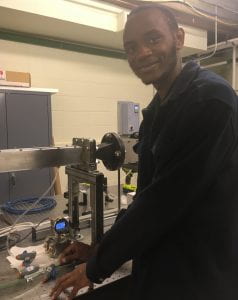
Toluwani is from Community College of Rhode Island (CCRI). His major is Mechanical Engineering. His summer research project at UMass Dartmouth is on “Evaluation of Hierarchical Super-Hydrophobic Surfaces for Friction Reduction in Turbulent Flows”. The objectives of his project are:
- Gain more knowledge on the effects of hierarchical structure on the ability of Superhydrophobic surfaces (SHS) to reduce drag in turbulent flows via experiments.
- Develop a technique that will allow to maximize the drag reducing ability of the SHS in scenarios of high pressure and turbulent flow.
Sara Amin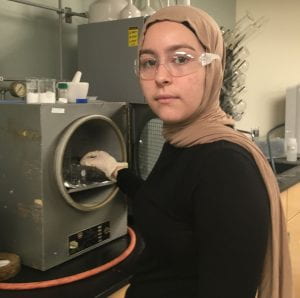
Sara is from Clovis Community College in California. Her major is Civil Engineering. Her summer research project at UMass Dartmouth is on “Developing Redox Booster Materials to Increase the Capacity of Non-aqueous Redox Flow Batteries”. The objectives of her project are:
- Prepare Cobalt hexacyanoferrate, a Prussian blue analog (PBA)-modified electrodes using various substrates such as glassy carbon, ITO glass and, FTO glass by dispersion drop-cast method.
- Collect cyclic voltammetry of the electrode and find the reduction potential using various reference electrodes.
- Study the effect of various amounts of potassium ion, which intercalates during the reduction step, on reduction potential.
- Prepare other Prussian blue analogs and repeat the above experiments.
Elizabeth Dennen
Elizabeth is from Community College of Rhode Island (CCRI). Her major is Biomedical Engineering. Her summer research project at UMass Dartmouth is on “Bioinspired Photonic Materials Based on Iridescent C. Lytica Bacteria”. The objectives of her project are:
- Cultivate the C. Lytica bacteria in BB2 liquid media and on agar plates and plot the growth cycle of C. Lytica
- Use the Allevi Bioprinter to 3D print C. Lytica and find optimal parameters
- Explore different substrates for 3D printing of the bacteria
- Better understand how to produce specific colors and figure out how to change those colors once they are produced
Theresa Dunigan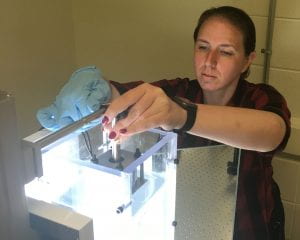
Theresa is from Community College of Rhode Island (CCRI). Her major is Chemical Engineering. Her summer research project at UMass Dartmouth is on “Drag Reduction of Superhydrophobic Spheres in Laminar Flow”. The objectives of her project are:
- Fully examine the potential for superhydrophobic surface coatings/treatments to reduce drag on stainless steel spheres in laminar flows
- Explore fabrication options for superhydrophobic surfaces on round objects to ensure optimal friction reduction which will in turn reduce required fuel consumption
- Utilize cutting edge experimental measurements while researching advanced nano-fabrication technologies
- Address a currently unexplored aspect of superhydrophobicity research by focusing on round surfaces rather than flat planar surfaces
Ayoub Ellouzi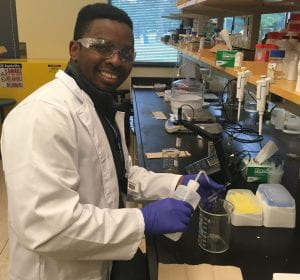
Ayoub is from Bunker Hill Community College (BHCC) in Massachusetts. His major is Mechanical Engineering. His summer research project at UMass Dartmouth is on “Determination of the Role of pH on the Surface Adsorption of Plasmonic nanoparticles on Gold Nanorods”. The objectives of his project are:
- Explore Photocatalysis of Chemical Reaction by using plasmonic nanoparticles (AuNR).
- Investigate the effect of pH on the growth of AuNR
- Understand the effect of pH on the adsorption (location and amount) of Polyvinylpyrrolidone (PVP) on the AuNR
Aries Erickson
Aries is from Snow College, Utah. His major is Electrical Engineering. His summer research project at UMass Dartmouth is on “Calculation of the solvation energy of non-aqueous redox flow battery”. The main objective of the project is to explore the applicability of a mixed explicit-implicit solvation model in describing Gibb’s free energy of solvation battery electrolytes. Specific objectives are as follows:
- Find necessary and scalable CPU power required to run certain calculations
- Find optimal geometries and structures for each added molecule 1-19 of the first shell in the system
- Calculate solvation energy for each of the optimal geometries
- Compare and find convergence for solvation energy vs number of molecules
David Kamp
David is from Cape Cod Community College (CCCC) in Massachusetts. His major is Mechanical Engineering. His summer research project at UMass Dartmouth is on “Slim Form Factor Tactile Sensors for Soft Bodied Underwater Robots”. The objectives of his project are:
- to create a sensor for a soft bodied robot that is able to detect normal and shear forces
- to be contained within a slim form factor to limit impeding the motion of a soft robot
- to be Waterproofed to work in marine environments
Audra Palmer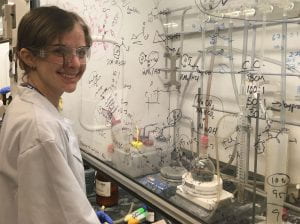
Audra is from Lorain County Community College, Ohio. Her major is Organic Chemistry. Her summer research project at UMass Dartmouth is on “Synthesis of Hesperine Analogs for Biofouling Purposes as Inspired by Marine Sponge Agelas Conifera”. The objectives of her project are:
- Synthesize a variety of analogs (n≈20) to the natural compound Hesperine
- Identify a lead compound by lab based screenings
- Determine the antibiofouling properties of the lead through field tests
- Make improvements until the compound can successfully be added to paint and applied
Ethan Ramirez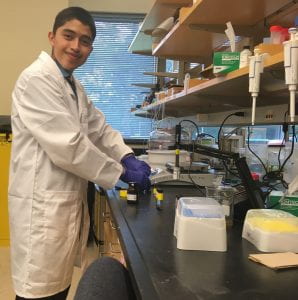
Ethan is from Ventura College, California. His major is Electrical Engineering. His summer research project at UMass Dartmouth is on “Optical Camouflage (Squid)”. This project hopes to replicate the squid’s defensive ability by creating plasmonic ink that can change colors to match its surroundings. The objectives of his project are:
- Find a material that allows itself to change color when plasmonic ink is applied.
- Create Plasmonic Ink using gold nanoparticles that emit specific colors.
- Create a clothing material with plasmonic ink that becomes disguised to its surroundings.
Maghen Saltzman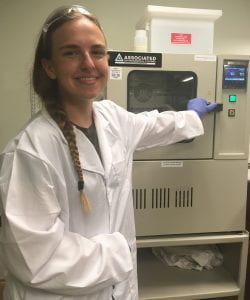
Maghen is from Bakersfield College, California. Her major is Mechanical Engineering. Her summer research project at UMass Dartmouth is on “Effect of Composition on the Properties of Solid Electrolytes”. The objectives of her project are:
- Prepare samples of polyethylene terphthalate (PET)+ lithium bis(trifluoromethanesulfonyl) imide (LiTSFI) over a range of compositions and prepare samples using injection molding
- Characterize thermal properties using Differential scanning calorimetry (DSC) and ionic conductivity using Electrochemical Impedance Spectroscopy (EIS)
- Characterize mechanical properties under three-point bending and tensile loading conditions
- Interpret test results to determine whether PET+LiTSFI is a suitable electrolyte for this project or whether a different electrolyte combination should be pursued